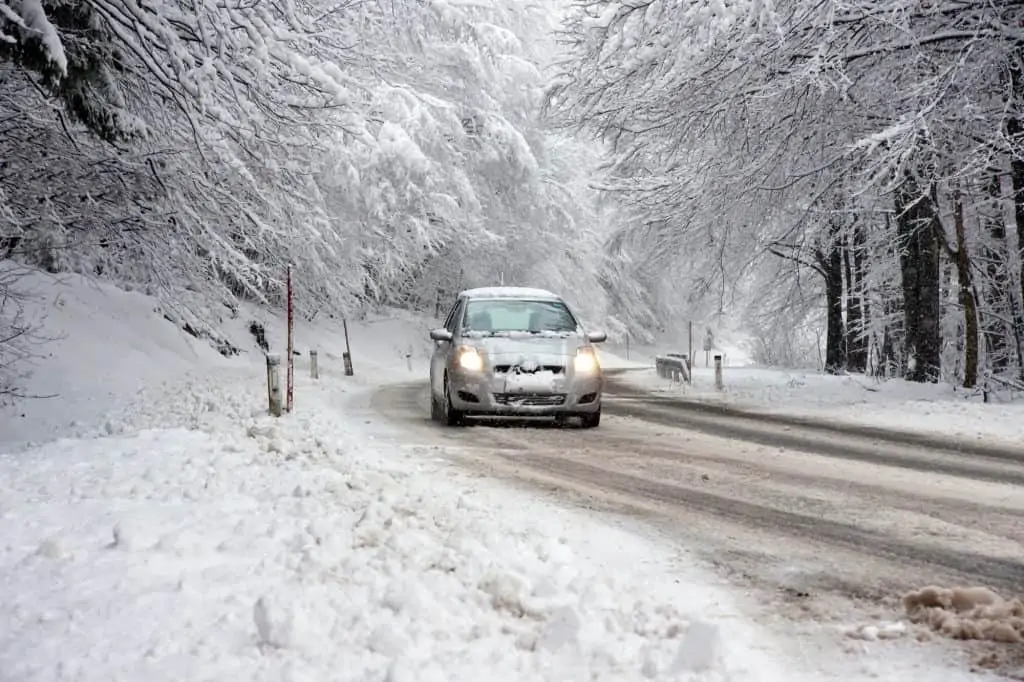When living in an area prone to winter conditions that include frigid temperatures, brisk snowstorms and ice-covered roads, there are certain precautions drivers need to take into account when it comes to safe winter driving.
While the majority of motorists navigate the winter months without much hassle, it’s helpful to brush up on basic winter driving suggestions, whether you’re a new driver, you’re new to an area with four seasons, or you’re an experienced winter driver in need of a refresher.
To help you stay safe with the changing weather conditions, here are a few standard winter driving tips to keep in mind:
Ensure Your Vehicle Is Ready for Winter
The first step to driving safely in wintertime is making sure your vehicle is prepared to handle the cold environment. This includes:
- Use all-weather or snow tires that are in good condition and comply with local traction and chain laws. These laws are set in place to make sure tires and vehicles are capable of properly gripping slippery roads.
- Make sure your windshield wipers work properly. It is both illegal and unsafe to drive with an obstructed windshield view.
- Keep all fluids at proper levels. Before any lengthy journey, get your fluids topped off and change the oil if necessary.
- Make sure your battery is in solid shape. Batteries operate less efficiently in cold weather, so using one with a good cold-crank rating is preferable.
- Keep your headlights and taillights clean, and make sure snow doesn’t build up in your tailpipe. If the tailpipe gets clogged, carbon monoxide can enter into your car, creating an extremely hazardous scenario.
- Only drive if your brakes are in optimal condition. It’s more difficult to stop in slippery conditions.
- When in doubt, have a maintenance professional look at your car. If you’re not especially mechanically inclined, it’s always best to take your car in for a thorough check-up by a professional.
- Keep an emergency care package in the car at all times. This should include a snow scraper, a snow shovel, a spare tire, window washer fluid, blankets, warm clothes, food, water, jumper cables, flashlights, emergency flares, and kitty litter (for traction).
- Always have a cell phone with you in the car. A way to communicate is necessary, but reserve it for emergencies or have a passenger operate it for you.
Take It Slow, Plan Ahead, and Allow Space for Other Drivers
Speed limits are designed for roads that are dry and obstacle-free. When the roads are icy, snowy or slushy, it becomes much harder to control your vehicle, a challenge that is amplified by higher speeds and sudden movements. Accelerating and braking gradually, turning gently, and reducing your speed will allow you to better react to hazardous situations as well as reduce your chance of skidding.
If you are concerned about getting somewhere on time in harsh weather, avoid the temptation to speed. Instead, try to plan ahead and leave early. In the case that you are a few minutes late, most people will understand the circumstances.
It’s also necessary to leave ample space between you and the cars around you, as this will give a cushion of room to react to hazards and maintain control over your vehicle. The general rule in Colorado is to leave about three seconds between you and the car in front of you, but you should at least double that during inclement weather. Be particularly mindful of commercial vehicles as they need more time and distance to stop.
Stay Updated on Road Closings and Upcoming Weather Conditions
One of the best safety measures you can take during stormy weather is to stay informed of upcoming weather reports and conditions. Radio stations and news reports will have the latest information, and you can even sign up to get weather alerts sent right to your phone so that you can check driving conditions just before getting on the road.
Weather can change swiftly, and storms can occasionally come on stronger than anticipated. When the weather is especially severe, safety officials may deem a road too dangerous to use and will temporarily close it. By learning this information in advance, you can safely shape your travel plans and take preventative measures.
Pay Attention to All Signs That Indicate Icy and Slippery Conditions
It’s common to see traffic signs warning drivers of areas that are likely to be slippery and covered with ice, but drivers are prone to ignoring these warnings if the roads don’t overtly appear hazardous. Even if the conditions seem to be dry and ice-free, it’s always wise to heed the warning when it’s cold outside.
Black ice is often hard to spot on the road, especially at nighttime. It’s also important to remember a bridge won’t be clear of ice just because the surrounding roads are, as bridges accumulate ice faster than roads do. This is because the surface underneath the road retains heat as temperatures drop, whereas bridges are exposed to the cold from all angles.
Avoid All Driving Distractions
While it’s always a good idea to avoid any distractions while driving, it’s exceptionally crucial during bouts of inclement weather. Because the control you have over your vehicle is impacted by the elements, the best thing to do is to fixate your eyes intently on the road and keep both hands on the wheel.
Texting should always be avoided while operating a vehicle, but in stormy, slippery conditions, it’s best to also refrain from talking on the phone, eating while driving, engaging in in-depth conversation, and even listening to loud music. Basically, if anything tempts your mind to wander and lose focus, it’s not worth the risk.
Steer in the Direction You Want the Car to Go During a Skid
Skids can occur when a driver loses traction after having braked too harshly, turned too forcefully, accelerated too aggressively, or driven at too high a speed. While it’s possible for skids to happen at any time, they most commonly occur when the road is wet and slippery.
Experiencing a skid is scary, but the good news is that it is largely preventable if you drive carefully and adapt your driving to match the unique conditions of the road and weather. That being said, it’s still important to know what to do if one does occur.
While it’s intuitive to keep your foot on the brake, doing so can actually make things worse. The first thing to do is to take your foot off of both the gas and the brake pedal. Keeping both hands on the wheel, quickly turn the wheel in the direction you want the car to go. You may need to turn it again in the other direction until the car evens out and aligns with the direction you want to travel.
Avoid Using Cruise Control
Cruise control is a convenient tool to use when you’re driving down a straight, dry stretch of road, but it’s safer to forgo it when there is rain, snow or ice on the ground.
It’s important to maintain as much control of your vehicle as possible when roads are slick. Using the cruise setting while driving on wet or icy roads can slow down your ability to react and take back control of your vehicle if a hazard were to occur. If your vehicle were to begin to slide or skid, you’d feel it faster and more noticeably if your foot was on the pedal, allowing you a greater window of time to properly respond.
Additionally, many drivers tap on the brakes to turn cruise control off, which would be dangerous to do so during a skid.
Remember the Basics
When it comes to preparing for winter driving, it’s important to make note of classic safe driving rules, such as:
- Don’t drink and drive, and always arrange for a sober driver if you plan on drinking.
- Always wear your seatbelt, and make sure all passengers do so as well.
- Don’t drive when you’re fatigued. If you have a long drive ahead of you, share the driving when possible or take regular breaks.
- Limit driving in severe weather as much as possible.
Consider Taking a Defensive Driving Course With DriveSafe Colorado
It’s perfectly natural for new drivers and those who have never experienced an authentic winter to feel intimidated about their first cold-weather season. Because there are more hazards on the road, bitter, blustery conditions can make even the most experienced drivers feel overwhelmed from time to time.
Defensive driving skills allow motorists to safely manage hazards by learning how to avoid them as well as learning what to do when they can’t. For over three decades, DriveSafe Colorado has been equipping drivers with the skills they need to safely navigate Colorado’s unique terrain and famous winters.
Our Colorado defensive driving course will show you how to expertly maneuver the car in unexpected situations, helping you develop the confidence and skills to stay safe in emergency situations throughout all seasons.
Contact us today to find out how to enroll in our next Defensive Skills Day!













